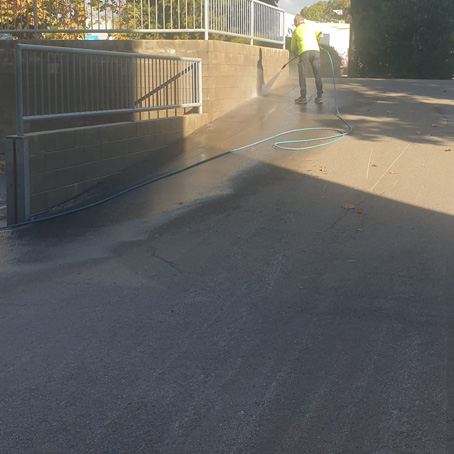Title: Preparing Your Driveway for Pressure Washing: Essential Tips and Steps
Pressure washing is an effective way to clean and maintain your driveway, removing dirt, grime, mold, and mildew.
However, proper preparation is crucial to achieving the best results and protecting your driveway’s surface.
In this article, we’ll explore the steps to take and the items to use before pressure washing your driveway to ensure a thorough and safe cleaning.

Inspect and Repair
Before pressure washing your driveway, it’s essential to inspect it for any cracks, holes, or damage.
Repairing these issues beforehand will prevent water from seeping into the surface and causing further damage.
Use a concrete crack filler or asphalt repair product for minor damage.
If you notice significant damage or deterioration, consider contacting a professional for assessment and repair.
Remove Obstructions
Clear away any loose debris, such as leaves, twigs, and rocks, from the driveway’s surface.
Ensure that all vehicles, outdoor furniture, and other items are removed from the area to allow for a thorough cleaning.
Additionally, cover any nearby plants or vegetation with a tarp to protect them from the pressure washing process and any cleaning agents used.
Sweep and Pre-treat Stains
Using a broom or blower, sweep the entire surface of your driveway to remove dirt and loose debris.
Pay close attention to the edges and corners, as dirt and grime often accumulate in these areas.
For stubborn stains such as oil or grease, pre-treat them with a degreaser specifically designed for driveway cleaning.
Follow the manufacturer’s instructions for proper application and allow the product to sit for the recommended time before pressure washing.
Choose the Right Pressure Washer and Accessories
Selecting the appropriate pressure washer and accessories is the best way to achieving optimal driveway cleaning results without damaging your driveway.
A pressure washer with a PSI (pounds per square inch) between 2,000 and 3,000 is generally recommended for residential driveways.
Additionally, choose a nozzle with a wider spray angle (such as a 25- or 40-degree nozzle) to minimize the risk of damaging your driveway’s surface.
Prepare the Pressure Washer
Before starting, familiarize yourself with the pressure washer’s operation and safety features.
Attach the chosen nozzle and fill the detergent reservoir with a cleaning solution suitable for your driveway’s surface material.
If your pressure washer does not have a built-in detergent reservoir, you can apply the cleaning solution using a pump sprayer.
Protect Surrounding Areas
Cover any exposed electrical outlets, light fixtures, or other sensitive areas with plastic sheeting or waterproof tape to prevent water damage.
If your driveway is adjacent to your home’s exterior, close all windows and doors to prevent water intrusion.
Wet the Surface
Before starting the pressure washing process, wet the entire surface of your driveway with water.
This step helps to loosen the dirt and makes it easier for the pressure washer to remove debris.
Additionally, wetting the surface prevents the cleaning solution from drying too quickly, ensuring a more effective cleaning process.
Conclusion
Proper preparation is the key to achieving a thorough and safe cleaning when pressure washing your driveway.
By inspecting and repairing your driveway, removing obstructions, sweeping and pre-treating stains, choosing the right pressure washer and accessories, preparing the equipment, and protecting surrounding areas, you can ensure a successful and efficient pressure washing experience.
With proper care and maintenance, your driveway will look its best and last for years to come.

Leave A Comment